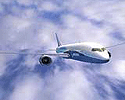has completed destructive testing on a full-scale composite wing box of the 787 Dreamliner as part of the new commercial aircraft’s certification process.
‘Successful completion of the wing box destruction test marks a major step forward in highlighting the innovation on the 787,’ said Mark Jenks, vice-president of 787 development. ‘In addition to determining the strength of the structure, the test helps us verify the analytical methods we have used to calculate the loads the structure will have to carry.’
The wing box (pictured below) is a cantilevered beam that carries the wing to the fuselage and supports leading and trailing-edge devices, control surfaces, engines and landing gear.
The test piece represents a portion of the wing section that begins at about the centre of the airplane and stops at approximately one-half of the span of the wing, or approximately 15.2m. The piece measures around 5.5m at its widest point.
The upper and lower surface panels and the spars of the wing are made of the same composite material being used on the fuselage. The wing ribs are monolithic aluminium structures.
To meet certification requirements, the wings must withstand loads up to 1.5 times, or 150 per cent, of the highest aerodynamic load that the jet could ever be expected to see in the entire lifetime of the 787 fleet.
The test wing box - designed and built by a joint team of Boeing, Mitsubishi Heavy Industries and Fuji Heavy Industries - weighed 55,000 pounds (24,947.58kg) and included hardware and instrumentation required for test-only.

Structural testing will continue on two full-scale 787 airframes as part of the certification process for the airplane. According to Boeing, those tests will further demonstrate the performance of the structure through multiple lifetimes of normal operational loads and test the structure beyond the points expected to be seen in service.




Nanogenerator consumes CO2 to generate electricity
Whoopee, they've solved how to keep a light on but not a lot else.